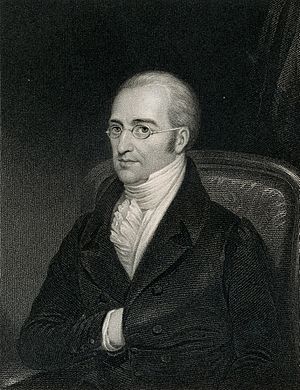John Cooke (physician) facts for kids
John Cooke (1756–1838) was an important English doctor. He was known for his work on nervous system diseases.
Contents
The Life of John Cooke
Early Life and Education
John Cooke was born in Lancashire, England, in 1756. When he was young, he was taught by Philip Doddridge. Doddridge was a well-known teacher who prepared people to become "dissenting ministers." This meant they were religious leaders who did not follow the official Church of England.
Cooke worked as a minister in towns like Rochdale and Preston. After some time, he decided to change his career. He became a medical student at Guy's Hospital in London. He then continued his studies at the University of Edinburgh and the University of Leyden. He earned his medical degree from the University of Leyden.
Medical Career in London
After finishing his studies, Cooke became a doctor at the Royal General Dispensary. This was a medical center in Bartholomew Close, located in the City of London. In April 1784, he was chosen to be a doctor at the London Hospital. He worked there for 23 years. He also gave the very first clinical lectures at that hospital. These lectures taught students about real patient cases.
On June 25, 1784, he was allowed to practice medicine by the Royal College of Physicians. This meant he was officially licensed. In 1807, he became a "fellow" of the College of Physicians. This is a high honor for doctors. Ten years later, he also became a Fellow of the Royal Society. The Royal Society is a very old and respected group for scientists.
Cooke gave special lectures called the Croonian lectures at the College of Physicians. He gave them in 1819, 1820, and 1821. In 1828, he also gave the Harveian oration. This is another important lecture given in honor of William Harvey, a famous doctor.
Later Years and Achievements
John Cooke was the president of the Medico-Chirurgical Society in 1822 and 1823. This was a group for doctors and surgeons. He was also a Fellow of the Society of Antiquaries of London. This society studies history and old objects.
In his later years, Cooke stopped practicing medicine. He did not go out much. He passed away at his home in Gower Street, London, on January 1, 1838.
John Cooke's Writings
His Book on Nervous Diseases
John Cooke wrote his medical thesis about using Peruvian bark. This bark was used as medicine, especially when people had fevers. His thesis looked at cases where there was no fever.
In 1820, he started writing a big book called A Treatise on Nervous Diseases. He finished this book in 1823. An American version of the book was printed in Boston in 1824. This book was based on his Croonian lectures.
Cooke's book described what doctors knew at the time about many nervous system problems. These included:
- Hemiplegia (paralysis on one side of the body)
- Paraplegia (paralysis of the lower body)
- Paralysis of single nerves
- Epilepsy (a brain disorder causing seizures)
- Apoplexy (a sudden loss of consciousness, often due to a stroke)
- Lethargy (a state of extreme tiredness)
- Hydrocephalus internus (a condition where fluid builds up in the brain)
His book did not introduce many new ideas. But it was a good summary of existing knowledge. His way of writing was similar to his friend Thomas Young. Thomas Young was a famous scientist who also wrote a book about diseases in 1815.


